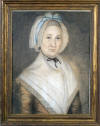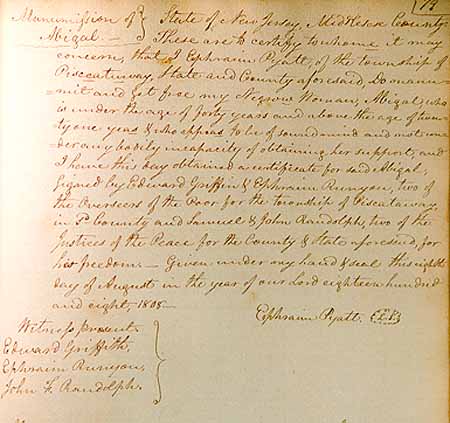|
1776 |
 |
In December, the first New Jersey campaign of the Revolutionary War,
the Battle of Trenton, propelled New Jersey into the conflict. New Jersey women were found
on both loyalist and patriot sides. Farms, homes, and public buildings were devastated.
|
| |
 |
In December, the first New Jersey campaign of the Revolutionary War,
the Battle of Trenton, propelled New Jersey into the conflict. New Jersey women were found
on both loyalist and patriot sides. Farms, homes, and public buildings were devastated. |
| |

|
The first New
Jersey Constitution (July 2) gave "all inhabitants . . . worth fifty pounds
proclamation money" the right to vote. The omission of the term male allowed female
property owners to vote, a right that was revoked by the New Jersey legislature on
November 16,1807. |
| |
|
|
| 1778 |
|
The legendary Molly Pitcher (Mary Ludwig Hays McCauley,
1754-1832) brought water to the troops at the Battle of Monmouth (June 28,1778) and
reportedly took her husband's place after he was wounded. She was awarded a state pension
in 1822. |
| |
|
The legendary Molly Pitcher (Mary Ludwig Hays McCauley,
1754-1832) brought water to the troops at the Battle of Monmouth (June 28,1778) and
reportedly took her husband's place after he was wounded. She was awarded a state pension
in 1822. |
| |
|
Morven, the Princeton estate of Annis Boudinot Stockton (1736-1801),
was ransacked and occupied by the British in December. Stockton hid papers and documents
of the American Whig society, preserving them for history. |
| |
|
|
| 1779 |
|
The widow Theodosia Johnes Ford (1741-1824) opened her home and
grounds in Morristown to General George Washington as his headquarters.
|
| |
|
|
| 1780 |
 |
In July, women in Trenton organized a statewide fund
raising effort to aid in financing the Continental Army and those who
"suffered, fought and bled in the cause of virtue and their oppressed
country." |
| |
|
|
| 1783 |
 |
In January 1783, the Articles of Peace were signed. In
February, Great Britain ceased hostilities with the United States.
The Revolutionary War was over. Annis Boudinot Stockton sent this poem of
gratitude to General George Washington, 1783. |
| |
|
|
| 1785 |
 |
Sculptor and widow, Rachel Lovell Wells (1735-1796) of
Bordentown, submitted the first of three petitions to the New Jersey
Legislature requesting repayment of money she had lent it for the war
effort. Her petition was denied. |
| |
|
|
| 1789 |
 |
George Washington was inaugurated president and on his
journey to New York City, visited in Trenton where he was honored by young
women. |
| |
 |
|
| |
|
|
| 1790 |
 |
The
New Jersey legislature passed a law that referred to "he or she" when describing
voters, thus reinforcing the idea that women were voters. |
| |
|
|
| 1797 |
 |
The New Jersey legislature revised the
voting law; the term "he or she" was retained when describing voters.
|
| |
 |
There were reportedly 12,422 slaves, male and female, in New Jersey at
the turn of the century. New Jersey was the last northern state to abolish slavery. |
| |
|
|
| 1800 |
 |
The population of New Jersey was approximately 211,000 people, 45.5%
of whom were female. 8.1% were black, slave and free. The Lenape people were all but
eradicated in New Jersey; their population was estimated at 200.
Over 50 percent of immigrants to New Jersey came from England. |
| |
 |
After the Revolution, education for girls became a more accepted concept, at least within privileged families. Some of the several academies for boys which were founded in larger towns in New Jersey by 1810, also admitted girls, in separate departments. |
| |
|
|
| 1801 |
|
The Brotherton Indian reservation was disbanded and many of the
remaining Lenape women and men left the state. |
| |
|
|
| 1803 |
 |
The "Female Society for the Relief of Poor and Distressed
Persons in the Village of Newark" was organized and run by Rachel
Bradford Boudinot (1764-1805) in her home at 74 Park Place. Perhaps the earliest
charitable organization in the state, it was later renamed the Newark Female Charitable
Society and continued to serve Newark residents. |
| |
 |
|
| |
|
|
| 1804 |
 |
The New Jersey legislature passed a
gradual abolition law providing that the children of slaves, born
after July 4, 1804, should be freed; they could remain the servants of
the masters of their enslaved mothers until the age of 21 if female
and 25 if male. |
| |
 |
|
| |
 |
|
| |
|
|
| 1807 |
 |
On November 16,
the New Jersey legislature passed a law for "the enfranchisement for all free, white,
male citizens" with a taxpayer requirement, thereby revoking the voting rights of all
women and free African-American men. |
| |
|
|
| 1813 |
|
A Female Charitable Society was founded to serve the poor by
Morristown women with the help of Louisa S. Macculloch (1785-1863) who became its
first directress. The organization still operates as the Family Service of Morris County. |
| |
|
|
| 1817 |
 |
Charlotte Bonaparte, (1802-1839)and her family were forced to flee their homeland eventually settling in Bordentown, where they lived from 1817-1832.
Bonaparte sketched and painted early 19th century New Jersey scenes and
landscapes.
|
| |
|
|
| 1820 |
|
The population of New Jersey was about 278,000 people, 49.3% of whom
were female and 7.2% of whom were black. Only 2.5 % of the people lived in urban areas.
|
| |
|
|
| 1821 |
 |
Jarena Lee (1783-unknown), the first known woman preacher of the African
Methodist Episcopal Church, began leading prayer meetings in Snow Hill. During her career,
she preached in many New Jersey towns. |
| |
|
|
|
1822 |
 |
Baroness Hyde de Neuville, (unknown - 1849) an accomplished painter often depicted scenes
of American life as well as pictures of African Americans and Native
Americans.
|
| |
|
|
| 1828 |
|
Children, including a large number of girls, employed in the cotton
mills of Paterson went out on strike for a ten-hour day. This was one of New Jersey’s
earliest strikes. |
| |
|
|
| 1835 |
|
Fifteen hundred girls and boys employed in Paterson cotton mills
struck again in protest over the 13 ˝ hour work day. As a result of their strike the
Paterson Association for the Protection of the Working Classes was formed. |
| |
|
|
| 1836 |
|
The New Jersey legislature passed a law requiring a jury trial
before runaway slaves could be returned to their masters. |
| |
|
|
| 1837
|
 |
Hannah Hoyt, a noted educator in New
Brunswick began her teaching career of educating young women. |
| |
|
St.
Mary’s Hall, a school for girls, was founded in 1837 by George W. Doane,
Episcopal Bishop of New Jersey. It offered girls the same demanding
curriculum as boys and soon became one of the country's outstanding
girls’ schools. Today it is known as St. Mary’s Hall/Doane
Academy and is co-ed.
|
| |
|
|
| 1840 |
|
The population of New Jersey was about 373,000 people, 49.6% of whom
were female and 5.9% of whom were black, and 10.7% lived in urban areas.
|
| |
 |
Esther "Hetty" Saunders, whose father escaped
from slavery in Delaware, wrote poetry. Saunders lived most of her
life in Mannington and Elsinboro, Salem
County. |
| |
|
|
| 1843 |
 |
The North American Phalanx, a middle-class utopian community, was
established in Red Bank. It was founded by Rebecca Buffum Spring (1811-1911) and her
husband Marcus Spring and continued until 1855. Women, such as Mary Paul (1830-unknown),
lived and worked in the community, reportedly on a par with men.
|
| |
|
|